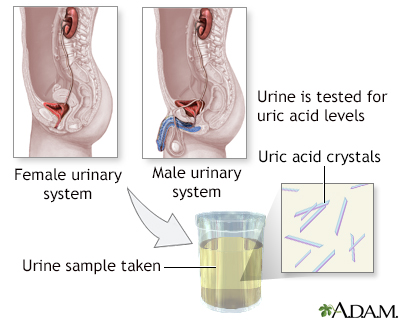 Uric acid test" width="440" />
Uric acid test" width="440" />The uric acid urine test measures the level of uric acid in the urine. The uric acid blood level can be checked using a blood test.
 Uric acid test" width="440" />
Uric acid test" width="440" />
Uric acid urine test is performed to check for the amount of uric acid in urine. Urine is collected over a 24 hour period and is sent to the laboratory for testing. The most common reason for measuring uric acid levels is in the diagnosis or treatment of gout, because gout results from crystallization of uric acid crystals in joints. Some kidney stones are also composed of uric acid.

These spiked rods are uric acid crystals photographed under polarized light. Increased uric acid blood levels and formation of uric acid crystals in the joints are associated with gout.
A 24-hour urine sample is often needed. You will need to collect your urine over 24 hours. Your health care provider will tell you how to do this. Follow instructions exactly.
Do not stop taking any medicine before talking to your provider.
Be aware that alcoholic drinks, vitamin C, and x-ray dye can also affect test results.
The test involves only normal urination. There is no discomfort.
This test may be done to help determine the cause of a high uric acid level in the blood. It may also be done to monitor people with gout, and to choose the best medicine to lower the uric acid level in the blood.
Uric acid is a chemical created when the body breaks down substances called purines. Most uric acid dissolves in blood and travels to the kidneys, where it passes out in urine. If your body produces too much uric acid or does not remove enough of it, you may get sick. A high level of uric acid in the body is called hyperuricemia and it can lead to gout or kidney damage.
This test may also be done to check whether a high uric acid level in the urine is causing kidney stones.
Normal values range from 250 to 750 mg/24 hours (1.48 to 4.43 mmol/24 hours).
Normal value ranges may vary slightly among different laboratories. Some labs use different measurements or test different samples. Talk to your provider about the meaning of your specific test results.
A high uric acid level in the urine may be due to:
A low uric acid level in the urine may be due to:
There are no risks with this test.
Dalbeth N. Clinical features and treatment of gout. In: Firestein GS, Budd RC, Gabriel SE, Koretzky GA, McInnes IB, O'Dell JR, eds. Firestein and Kelley's Textbook of Rheumatology. 11th ed. Philadelphia, PA: Elsevier; 2021:chap 101.
Riley RS, McPherson RA. Basic examination of urine. In: McPherson RA, Pincus MR, eds. Henry's Clinical Diagnosis and Management by Laboratory Methods. 24th ed. Philadelphia, PA: Elsevier; 2022:chap 29.
Last reviewed on: 8/20/2023
Reviewed by: Jacob Berman, MD, MPH, Clinical Assistant Professor of Medicine, Division of General Internal Medicine, University of Washington School of Medicine, Seattle, WA. Also reviewed by David C. Dugdale, MD, Medical Director, Brenda Conaway, Editorial Director, and the A.D.A.M. Editorial team.